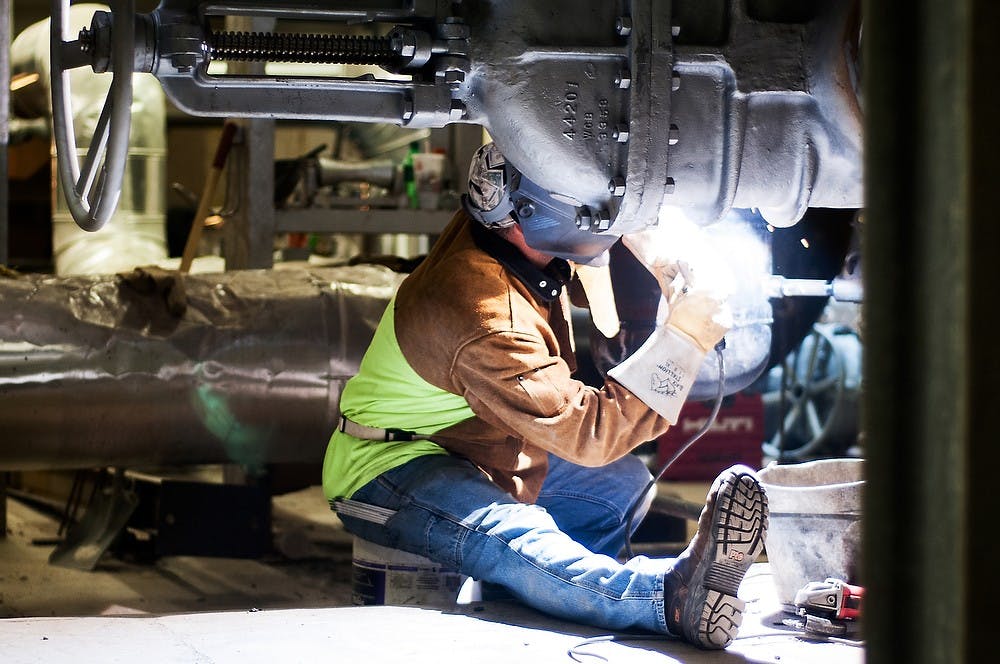As students trek to class during the seemingly endless winter months at MSU, they may experience a fleeting moment of relief as they pass over a small circle of salvation from the frigid cold.

Eagle, Mich., resident Josh Simon welds steam pipes June 17, 2014, in the steam tunnels in front of the Hannah Administration Building. MSU Infrastructure and Planning Facilities is working on replacing the arch tunnels. Corey Damocles/The State News
—
As students trek to class during the seemingly endless winter months at MSU, they may experience a fleeting moment of relief as they pass over a small circle of salvation from the frigid cold.
That circle is a grate that provides a glimpse into an underworld of warm, interlocking steam tunnels responsible for distributing heat to campus buildings.
“Some of our steam tunnels are 100 years old, and we’ve also had cogeneration on this campus for 100 years,” said Lynda Boomer, energy and environment design administrator for Infrastructure Planning and Facilities.
Director of Building Services Gus Gosselin said there are currently 12.3 miles of tunnel beneath campus, tended to by less than six workmen who maintain all underground utilities and walk the tunnels almost daily to check for and repair steam traps and any other issues.
A part of MSU’s campus many students are not aware of, the tunnels have their own storied history.
Steam service
The tunnels were constructed in order to produce central heating for campus, Boomer said. Prior to their implementation, MSU used wood and fireplaces in campus buildings, which caused a number of fires.
“(The steam tunnels) are the primary source of heat for about 18 to 19 million square feet of campus,” she said.
MSU project representative Andy Linebaugh said the steam is used for both heating the buildings’ domestic water for showers and laundry, and heating and cooling the buildings themselves.
“Steam is generated through the process of producing electricity for the campus, through our boilers, and then through the power plant,” he said. “It’s sent all through the campus under pressure ... it’s used in the buildings and for heating the water and then ... as it cools it condenses, and that condensate is collected and pressurized and sent back to the power plant for reuse.”
Linebaugh said the tunnels are safe to be in and only become problematic if they are not maintained well.
“The pipe is made out of metal, so it will deteriorate over time — and that’s part of the reason they’re being redone,” he said. “The tunnels are often made out of concrete, and some of the older ones ... were actually made out of masonry. They’ve stayed there a long time, but everything does have a shelf life.”
But because of the vital role the tunnels play in MSU’s infrastructure, their necessary maintenance can prove costly.
An aging infrastructure
The current project in north campus — the third phase for that specific tunnel — is about a $17 million project that will serve multiple buildings for a number of years ahead, Boomer said.
“It’s a very wise investment to maintain those tunnels,” she said. “The old arch tunnels were structurally no longer sound, so we needed to do something to heat those buildings.”
Gosselin estimated this year, roughly $410,000 will be allotted to maintaining the steam tunnels.
Boomer said while MSU is exploring alternative energy sources such as geothermal, wind and solar energy, the steam tunnels will continue to be used for quite some time. She said in the near future, the adjustment would likely be moving from coal towards natural gas and biofuels — so the steam would simply be generated from a different source.
“We’re investing an amount of money there that I would foresee ... at least 30 to 50 years out that we’re going to be generating some sort of steam to heat campus,” Boomer said.
Support student media! Please consider donating to The State News and help fund the future of journalism.
Myths and history
“In the seventies, there was a game called Dungeons & Dragons, and there were stories around the tunnels at that time ... just like a lot of folklore on campus, it kind of carried on for a while,” Boomer said.
The myths Boomer is referring to stemmed from the disappearance of MSU student James Dallas Egbert III, a troubled 16-year-old computer science prodigy in August 1979.
As speculation initially swirled around the case, which became a high-profile mystery that garnered national media attention, MSU officials said in a New York Times article they believed Egbert may have become lost in the tunnels. William Dear, a private investigator hired to find Egbert, combed the tunnels in search of the student but told The New York Times in the article he believed Egbert was dead.
The ensuing media frenzy around his disappearance, and his subsequent discovery by Dear in Louisiana almost a month later, garnered national attention around MSU’s steam tunnels, which took on a sinister air in media reports.
According to a book written by Dear afterwards entitled “The Dungeon Master,” Egbert entered the tunnels through the basement of Case Hall and, on Aug. 15, 1979, traveled to an “alcove” he had staked out. Egbert brought Quaaludes, a sedative, with him, and attempted suicide by consuming a supposedly lethal dosage. However, the pills failed, and Egbert awoke the next night and crawled about a mile to a friend’s house.
In the book, Dear said Egbert admitted to entering the tunnels about 200 times — sometimes four or five times per day — to play Dungeons & Dragons with others or to find some alone time.
Egbert died in 1980 from a self-inflicted gunshot wound — but his legacy lived on through the subsequent media frenzy and the rumors surrounding the steam tunnels afterwards.